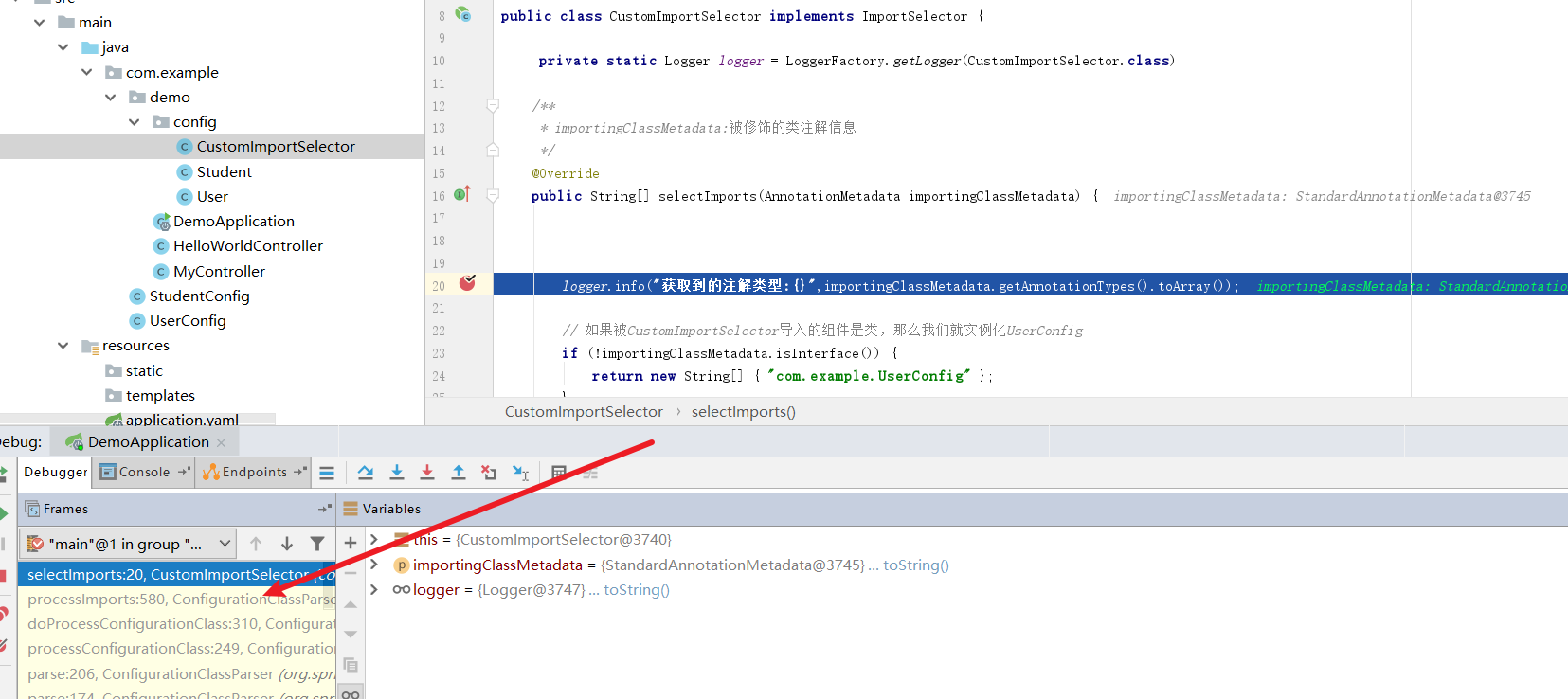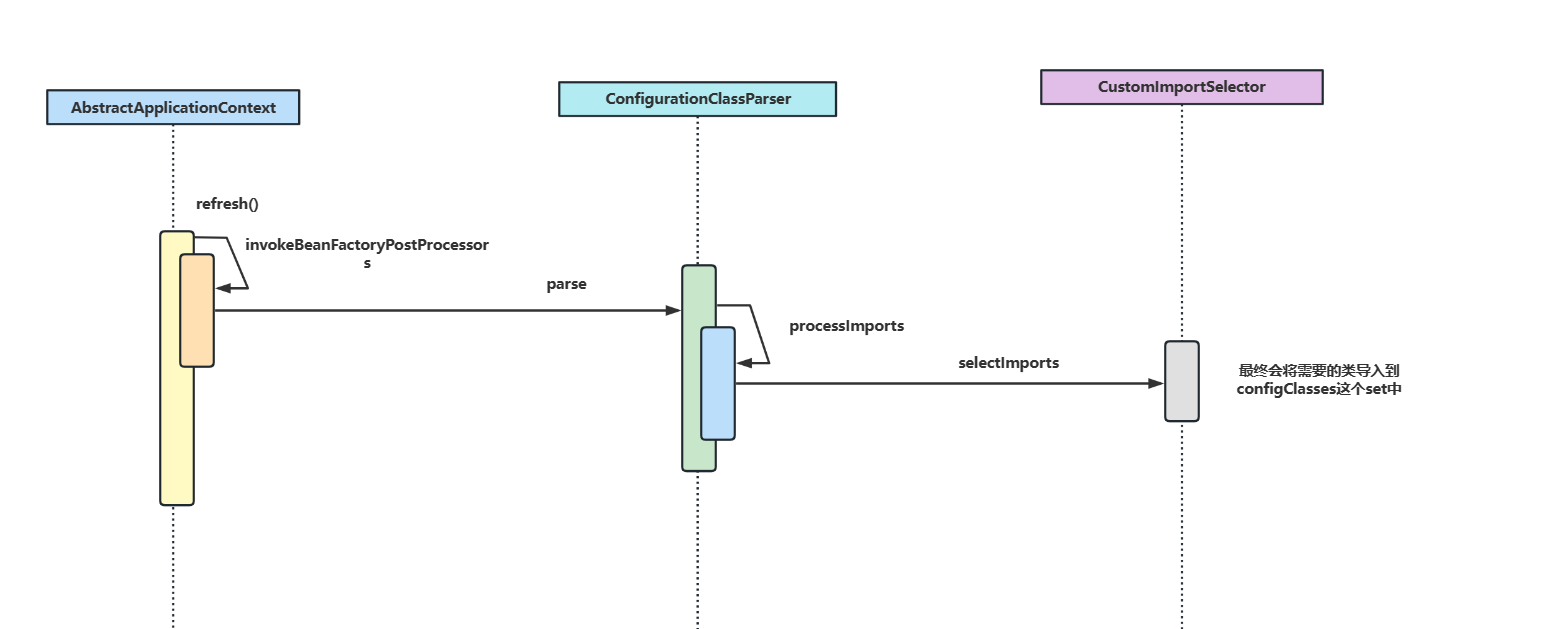Spring Boot自动装配原理以及实践
了解自动装配两个核心
@Import注解的作用
@Import说Spring框架经常会看到的注解,它有以下几个作用:
- 导入
@Configuration类下所有的@bean方法中创建的bean。 - 导入
import指定的bean,例如@Import(AService.class),就会生成AService的bean,并将其导入到Spring容器中。 - 结合
ImportSelector接口类导如指定类。(后文会展开介绍)
ImportSelector详解
ImportSelector接口则是前者的辅助者,如果我们希望可以选择性的导入一些类,我们就可以继承ImportSelector接口编写一个ImportSelector类,告知容器需要导入的类。就以Spring Boot为例,它有个@EnableAutoConfiguration注解,其工作原理就是基于内部的@Import({AutoConfigurationImportSelector.class})注解将AutoConfigurationImportSelector导入容器中,Spring就会调用其selectImports方法获取需要导入的类,并将这些类导入容器中。
@Override
public String[] selectImports(AnnotationMetadata annotationMetadata) {
if (!isEnabled(annotationMetadata)) {
return NO_IMPORTS;
}
AutoConfigurationEntry autoConfigurationEntry = getAutoConfigurationEntry(annotationMetadata);
//返回需要导入的类的字符串数组
return StringUtils.toStringArray(autoConfigurationEntry.getConfigurations());
}
使用示例
可能上文的原理对没有接触源码的读者比较模糊,所以我们不妨写一个demo来了解一下这个注解。我们现在有一个需求,希望通过import注解按需将Student类或者User类导入容器中。首先我们看看user类代码,没有任何实现,代码示例如下:
public class User {
}
Student 类代码同理,没有任何实现仅仅做测试使用
public class Student {
}
完成测试类的创建之后,我们就以用户类为例,创建UserConfig 代码如下:
@Configuration
public class UserConfig {
@Bean
public User getUser() {
return new User();
}
}
然后编写ImportSelector 首先类,编写自己的导入逻辑,可以看到笔者简单实现了一个selectImports方法返回UserConfig的类路径。
public class CustomImportSelector implements ImportSelector {
private static Logger logger = LoggerFactory.getLogger(CustomImportSelector.class);
/**
* importingClassMetadata:被修饰的类注解信息
*/
@Override
public String[] selectImports(AnnotationMetadata importingClassMetadata) {
logger.info("获取到的注解类型:{}",importingClassMetadata.getAnnotationTypes().toArray());
// 如果被CustomImportSelector导入的组件是类,那么我们就实例化UserConfig
if (!importingClassMetadata.isInterface()) {
return new String[] { "com.example.UserConfig" };
}
// 此处不要返回null
return new String[] { "com.example.StudentConfig" };
}
}
完成这些步骤我们就要来到最关键的一步了,在Spring Boot启动类中使用@Import导入CustomImportSelector
@SpringBootApplication
@Configuration
@Import(CustomImportSelector.class)
public class DemoApplication {
public static void main(String[] args) {
SpringApplication.run(DemoApplication.class, args);
}
}
为了测试我们编写这样一个controller看看bean是否会导入到容器中
@RestController
public class MyController {
private static Logger logger = LoggerFactory.getLogger(MyController.class);
@Autowired
private User user;
@RequestMapping("hello")
public String hello() {
logger.info("user:{}", user);
return "hello";
}
}
结果测试我们发现user不为空,说明CustomImportSelector确实将UserConfig导入到容器中,并将User导入到容器中了。
从源码角度了解ImportSelector工作原理
关于源码分析其实也很好做,感兴趣的读者可以直接在CustomImportSelector打个断点就能知道工作原理了:

断点之后我们不妨用以终为始的方式了解一下过程,首先入口是AbstractApplicationContext的refresh()方法,它会调用一个invokeBeanFactoryPostProcessors(beanFactory);进行bean工厂后置操作
@Override
public void refresh() throws BeansException, IllegalStateException {
synchronized (this.startupShutdownMonitor) {
.........
invokeBeanFactoryPostProcessors(beanFactory);
........
}
}
步入代码,可以看到容器会不断遍历各个postProcessor 即容器后置处理器,然后执行他们的逻辑
for (BeanFactoryPostProcessor postProcessor : beanFactoryPostProcessors) {
.....
//执行各个postProcessor 的逻辑
invokeBeanDefinitionRegistryPostProcessors(currentRegistryProcessors, registry, beanFactory.getApplicationStartup());
}
重点来了,遍历过程中得到一个ConfigurationClassPostProcessor,这个类就会得到我们的CustomImportSelector,然后执行selectImports获取需要导入的类信息,最终会生成一个Set<ConfigurationClass> configClasses = new LinkedHashSet<>(parser.getConfigurationClasses());
如下图所示可以看到configClasses就包含UserConfig

总结一下核心流程的时序图

完成上述步骤后ConfigurationClassPostProcessor就会通过这个set集合执行loadBeanDefinitions方法将需要的bean导入到容器中,进行后续IOC操作。

上图代码如下所示:
//configClasses 中就包含了UserConfig类
Set<ConfigurationClass> configClasses = new LinkedHashSet<>(parser.getConfigurationClasses());
configClasses.removeAll(alreadyParsed);
//执行 loadBeanDefinitions
this.reader.loadBeanDefinitions(configClasses);
Spring Boot自动装配原理(重点)
了解了import原理后,我们了解Spring Boot自动装配原理也很简单了,我们不妨看看Spring Boot的@SpringBootApplication这个注解中包含一个@EnableAutoConfiguration注解,我们不妨点入看看,可以看到它包含一个@Import(AutoConfigurationImportSelector.class)注解,从名字上我们可以知晓这是一个ImportSelector的实现类。
所以我们不妨看看它的selectImports逻辑,可以看到它会通过getAutoConfigurationEntry方法获取需要装配的类,然后通过StringUtils.toStringArray切割返回。所以我们不妨看看getAutoConfigurationEntry
@Override
public String[] selectImports(AnnotationMetadata annotationMetadata) {
if (!isEnabled(annotationMetadata)) {
return NO_IMPORTS;
}
AutoConfigurationEntry autoConfigurationEntry = getAutoConfigurationEntry(annotationMetadata);
return StringUtils.toStringArray(autoConfigurationEntry.getConfigurations());
}
查看getAutoConfigurationEntry方法,我们可以看到它通过getCandidateConfigurations获取各个xxxxAutoConfigure,并返回结果
protected AutoConfigurationEntry getAutoConfigurationEntry(AnnotationMetadata annotationMetadata) {
if (!isEnabled(annotationMetadata)) {
return EMPTY_ENTRY;
}
AnnotationAttributes attributes = getAttributes(annotationMetadata);
//获取所有xxxxAutoConfigure
List<String> configurations = getCandidateConfigurations(annotationMetadata, attributes);
//移除不需要的
configurations = removeDuplicates(configurations);
Set<String> exclusions = getExclusions(annotationMetadata, attributes);
checkExcludedClasses(configurations, exclusions);
configurations.removeAll(exclusions);
configurations = getConfigurationClassFilter().filter(configurations);
fireAutoConfigurationImportEvents(configurations, exclusions);
//返回结果
return new AutoConfigurationEntry(configurations, exclusions);
}

而getCandidateConfigurations实际上是会通过一个loadSpringFactories方法,如下所示遍历获取所有含有META-INF/spring.factories的jar包
private static Map<String, List<String>> loadSpringFactories(ClassLoader classLoader) {
Map<String, List<String>> result = (Map)cache.get(classLoader);
if (result != null) {
return result;
} else {
HashMap result = new HashMap();
try {
//解析这个配置文件获取所有配置类然后返回
Enumeration urls = classLoader.getResources("META-INF/spring.factories");
.....
return result;
} catch (IOException var14) {
throw new IllegalArgumentException("Unable to load factories from location [META-INF/spring.factories]", var14);
}
}
}
最终结果过滤解析,回到我们上文说的beanDefinitionMap中,最终通过IOC完成自动装配。
实践1-手写Spring Boot Starter中间件
了解自动装配我们不妨自己写一个中间件实践一下,现在需求如下,我们希望某些类的接口只有某几个用户可以访问,所以我们希望编写一个中间件判断请求用户是什么身份,如果没有权限则直接返回报错。
首先我们编写一个注解DoDoor ,用key记录传入的用户id,returnJson返回没有权限的响应结果
@Retention(RetentionPolicy.RUNTIME)
@Target(ElementType.METHOD)
public @interface DoDoor {
String key() default "";
String returnJson() default "";
}
然后在编写StarterServiceProperties ,使用ConfigurationProperties将itstack.door前缀的值和当前类userStr绑定。
/**
* 通过"itstack.door前缀的配置获取userStr信息
*/
@ConfigurationProperties("itstack.door")
public class StarterServiceProperties {
private String userStr;
public String getUserStr() {
return userStr;
}
public void setUserStr(String userStr) {
this.userStr = userStr;
}
}
完成后在编写StarterService 这个类会将userStr切割成数组,例如我们传111,222,最终就会得到[111,222]
public class StarterService {
private String userStr;
public StarterService(String userStr) {
this.userStr = userStr;
}
public String[] split(String separatorChar) {
return StringUtils.split(this.userStr, separatorChar);
}
}
这些佐料写完之后,我们就可以编写一个AOP类了,可以看到这个AOP做的是很简单,就是拦截带有DoDoor的请求,将注解key配置的值和我们的userStr数组比对,若包含则放行,反之拦截。
@Aspect
@Component
public class DoJoinPoint {
private Logger logger = LoggerFactory.getLogger(DoJoinPoint.class);
@Autowired
private StarterService starterService;
@Pointcut("@annotation(org.itstack.door.annotation.DoDoor)")
public void aopPoint() {
}
@Around("aopPoint()")
public Object doRouter(ProceedingJoinPoint jp) throws Throwable {
//获取内容
Method method = getMethod(jp);
DoDoor door = method.getAnnotation(DoDoor.class);
//获取字段值
String keyValue = getFiledValue(door.key(), jp.getArgs());
logger.info("itstack door handler method:{} value:{}", method.getName(), keyValue);
if (null == keyValue || "".equals(keyValue)) return jp.proceed();
//配置内容
String[] split = starterService.split(",");
//白名单过滤
for (String str : split) {
if (keyValue.equals(str)) {
return jp.proceed();
}
}
//拦截
return returnObject(door, method);
}
private Method getMethod(JoinPoint jp) throws NoSuchMethodException {
Signature sig = jp.getSignature();
MethodSignature methodSignature = (MethodSignature) sig;
return getClass(jp).getMethod(methodSignature.getName(), methodSignature.getParameterTypes());
}
private Class<? extends Object> getClass(JoinPoint jp) throws NoSuchMethodException {
return jp.getTarget().getClass();
}
//返回对象
private Object returnObject(DoDoor doGate, Method method) throws IllegalAccessException, InstantiationException {
Class<?> returnType = method.getReturnType();
String returnJson = doGate.returnJson();
if ("".equals(returnJson)) {
return returnType.newInstance();
}
return JSON.parseObject(returnJson, returnType);
}
//获取属性值
private String getFiledValue(String filed, Object[] args) {
String filedValue = null;
for (Object arg : args) {
try {
if (null == filedValue || "".equals(filedValue)) {
filedValue = BeanUtils.getProperty(arg, filed);
} else {
break;
}
} catch (Exception e) {
if (args.length == 1) {
return args[0].toString();
}
}
}
return filedValue;
}
}
编写我们的AutoConfigure ,根据条件决定上述的类是否导入
@Configuration
@ConditionalOnClass(StarterService.class)
@EnableConfigurationProperties(StarterServiceProperties.class)
public class StarterAutoConfigure {
@Autowired
private StarterServiceProperties properties;
@Bean
@ConditionalOnMissingBean
@ConditionalOnProperty(prefix = "itstack.door", value = "enabled", havingValue = "true")
StarterService starterService() {
return new StarterService(properties.getUserStr());
}
@Bean
@ConditionalOnMissingBean
@ConditionalOnProperty(prefix = "itstack.door", value = "enabled", havingValue = "true")
DoJoinPoint doJoinPoint() {
return new DoJoinPoint();
}
}
完成后编写一个spring.factories,导入这个AutoConfigure
org.springframework.boot.autoconfigure.EnableAutoConfiguration=org.itstack.door.config.StarterAutoConfigure
修改一下pom,本地打个包
<dependency>
<groupId>org.springframework.boot</groupId>
<artifactId>spring-boot-starter-aop</artifactId>
</dependency>
<plugin>
<groupId>org.apache.maven.plugins</groupId>
<artifactId>maven-jar-plugin</artifactId>
<version>2.3.2</version>
<configuration>
<archive>
<addMavenDescriptor>false</addMavenDescriptor>
<index>true</index>
<manifest>
<addDefaultSpecificationEntries>true</addDefaultSpecificationEntries>
<addDefaultImplementationEntries>true</addDefaultImplementationEntries>
</manifest>
<manifestEntries>
<Implementation-Build>${maven.build.timestamp}</Implementation-Build>
</manifestEntries>
</archive>
</configuration>
</plugin>
在其他应用中导入
<dependency>
<groupId>org.itatack.demo</groupId>
<artifactId>door-spring-boot-starter</artifactId>
<version>1.0.1-SNAPSHOT</version>
</dependency>
编写配置
server:
port: 9887
spring:
application:
name: demo
# 自定义中间件配置
itstack:
door:
enabled: true
userStr: 1001,aaaa,ccc #白名单用户ID,多个逗号隔开
然后在导入这个中间件的应用中编写一个方法测试@DoDoor
@RestController
public class HelloWorldController {
@Autowired
private ApplicationContext applicationContext;
@DoDoor(key = "userId", returnJson = "{\"code\":\"1111\",\"info\":\"非白名单可访问用户拦截!\"}")
@RequestMapping(path = "/user", method = RequestMethod.GET)
public Map queryUserInfo(@RequestParam String userId) {
Map<String, DoJoinPoint> beansOfType = applicationContext.getBeansOfType(DoJoinPoint.class);
Map resultMap = new HashMap<>();
resultMap.put("虫虫:" + userId, "天津市南开区旮旯胡同100号");
return resultMap;
}
}
测试结果
C:\Users\xxxx>curl http://localhost:9887/user?userId=1001132
{"code":"1111","info":"非白名单可访问用户拦截!"}
C:\Users\xxx>curl http://localhost:9887/user?userId=1111
{"code":"1111","info":"非白名单可访问用户拦截!"}
C:\Users\xx>curl http://localhost:9887/user?userId=1001
{"虫虫:1001":"天津市南开区旮旯胡同100号"}
源码是借鉴小傅哥的,感兴趣的读者可以参考:
Spring Boot 中间件开发(一)《服务治理中间件之统一白名单验证》
实践2-通用日志组件
需求介绍
微服务项目中,基于日志排查问题是非常重要的手段,而日志属于非功能范畴的一个职责,所以我们希望将日志打印和功能解耦。AOP就是非常不错的手段,但是在每个服务中都编写一个切面显然是非常不可取的。
所以我们希望通过某种手段会编写一个通用日志打印工具,只需一个注解即可实现对方法的请求响应进行日志打印。
所以我们这个例子仍然是利用自动装配原理编写一个通用日志组件。
实现步骤
- 创建日志插件模块
cloud-component-logging-starter,并引入我们需要的依赖,如下所示,因为笔者要对spring-web应用进行拦截所以用到的starter-web和aop模块,以及为了打印响应结果,笔者也用到hutool,完整的依赖配置如下所示:
<dependencies>
<dependency>
<groupId>org.springframework.boot</groupId>
<artifactId>spring-boot-starter-web</artifactId>
</dependency>
<dependency>
<groupId>org.springframework.boot</groupId>
<artifactId>spring-boot-starter-aop</artifactId>
</dependency>
<dependency>
<groupId>cn.hutool</groupId>
<artifactId>hutool-all</artifactId>
</dependency>
</dependencies>
- 编写日志注解,如下所示,该注解的value用于记录当前方法要执行的操作,例如某方法上
@SysLog("获取用户信息"),当我们的aop拦截到之后,就基于该注解的value打印该方法的功能。
@Target(ElementType.METHOD)
@Retention(RetentionPolicy.RUNTIME)
public @interface SysLog {
/**
* 记录方法要执行的操作
*
* @return
*/
String value();
}
- 编写环绕切面逻辑,代码如下所示,逻辑非常简单,拦截到了切面后若报错则打印报错的逻辑,反之打印正常请求响应结果。
@Aspect
public class SysLogAspect {
private static Logger logger = LoggerFactory.getLogger(SysLogAspect.class);
@Pointcut("@annotation(com.zsy.annotation.SysLog)")
public void logPointCut() {
}
@Around("logPointCut()")
public Object around(ProceedingJoinPoint joinPoint) throws Throwable {
MethodSignature signature = (MethodSignature) joinPoint.getSignature();
Method method = signature.getMethod();
//类名
String className = joinPoint.getTarget().getClass().getName();
//方法名
String methodName = signature.getName();
SysLog syslog = method.getAnnotation(SysLog.class);
//获取当前方法进行的操作
String operator =syslog.value();
long beginTime = System.currentTimeMillis();
Object returnValue = null;
Exception ex = null;
try {
returnValue = joinPoint.proceed();
return returnValue;
} catch (Exception e) {
ex = e;
throw e;
} finally {
long cost = System.currentTimeMillis() - beginTime;
if (ex != null) {
logger.error("业务请求:[类名: {}][执行方法: {}][执行操作: {}][耗时: {}ms][请求参数: {}][发生异常]",
className, methodName, operator, joinPoint.getArgs(), ex);
} else {
logger.info("业务请求:[类名: {}][执行方法: {}][执行操作: {}][耗时: {}ms][请求参数: {}][响应结果: {}]",
className, methodName, operator, cost, joinPoint.getArgs(), JSONUtil.toJsonStr(returnValue));
}
}
}
}
- 编写配置类
@Configuration
public class SysLogAutoConfigure {
@Bean
public SysLogAspect getSysLogAspect() {
return new SysLogAspect();
}
}
- 新建
spring.factories告知要导入Spring容器的类,内容如下
org.springframework.boot.autoconfigure.EnableAutoConfiguration=\
com.zsy.config.SysLogAutoConfigure
- 其他服务引入进行测试,以笔者为例,方法如下
@SysLog("获取用户信息")
@GetMapping("getByCode/{accountCode}")
public ResultData<AccountDTO> getByCode(@PathVariable(value = "accountCode") String accountCode) {
log.info("远程调用feign接口,请求参数:{}", accountCode);
return accountFeign.getByCode(accountCode);
}
请求之后输出结果如下
2023-02-16 00:08:08,085 INFO SysLogAspect:58 - 业务请求:[类名: com.zsy.order.controller.OrderController][执行方法: getByCode][执行操作: 获取用户信息][耗时: 892ms][请求参数: [zsy]][响应结果: {"data":{"accountCode":"zsy","amount":10000,"accountName":"zsy","id":1},"message":"操作成功","success":true,"status":100,"timestamp":1676477287856}]
参考文献
@Import、ImportSelector注解使用及源码分析
Spring Boot 中间件开发(一)《服务治理中间件之统一白名单验证》
本文来自互联网用户投稿,该文观点仅代表作者本人,不代表本站立场。本站仅提供信息存储空间服务,不拥有所有权,不承担相关法律责任。 如若内容造成侵权/违法违规/事实不符,请联系我的编程经验分享网邮箱:chenni525@qq.com进行投诉反馈,一经查实,立即删除!